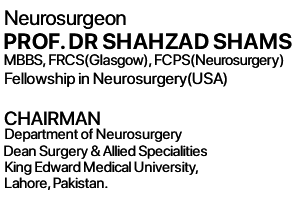Back Problems
Neurosurgeons treat a large number of problems with the lumbar spine like lower back problems. The more common ones include prolapsed intervertebral disc (slipped disc), spinal canal stenosis, and spinal tumours.
Prolapsed Intervertebral Disc (Slipped Disc)
The discs bulge backwards and press on a spinal nerve root. This can cause severe pain in the leg sciatica and backache, as well as weakness and sensory loss. Occasionally problems with the bladder and bowel may occur. The disc can be shown on magnetic imaging (MRI) and, if the symptoms are severe, can be removed by a microdiscectomy.
Spinal Stenosis
This means a progressive narrowing of the bony canal in the lumbar spine where the spinal nerves lie referred as Lumbar Spondylosis or Lumbar Spondylitis changes. It is due to the gradual wearing out of the bones and ligaments as we get older. It can restrict the blood supply to the spinal nerves causing pain in the legs, as well as weakness and sensory changes, particularly after walking. The stenosis shows up on magnetic imaging (MRI) and can often be treated by an operation: lumbar laminectomy
Lumbar Spinal Tumors
Tumors can occur in the lumbar spine, although they are fortunately not common. They can cause low back and leg pain as well as leg weakness and sensory changes. Problems with the bladder and bowels can also occur. They are usually imaged with a magnetic resonance scan (MRI). Some may need to be removed surgically via a laminectomy.
Neck Problems
Neurosurgeons treat a great many diseases of the cervical spine like neck problems. These include prolapsed intervertebral discs (slipped discs), canal stenosis (narrowing), and spinal tumours.
Prolapsed Intervertebral Disc (Slipped Disc)
The intervertebral discs bulge backwards in the neck and can press on the nerve roots going down the arm, causing severe arm pain, as well as weakness and sensory changes. A disc bulge can also press on the spinal cord itself, a potentially serious problem, which may cause weakness, sensory changes, alteration of bladder and bowel function, up to complete paralysis from the neck downwards. The disc is demonstrated using a magnetic resonance image (MRI). If necessary it can be surgically removed by an anterior cervical discectomy.
Cervical Canal Stenosis
The bones and ligaments of the cervical spine (neck) gradually wear out usually reffered as Cervical Spondylosis or Cervical Spondylitic changes . This causes the neck to lose some of its normal shape and the bony canal in which the spinal cord sits can become narrowed, sometimes quite severely. This pressure on the spinal cord can be quite serious, causing weakness, sensory loss and bladder and bowel changes, or even complete paralysis below the neck. The stenosis can be demonstrated by magnetic resonance imaging (MRI) and, if necessary, can be surgically treated by a cervical laminectomy.
Cervical Spinal Tumors
Tumors can occur in the cervical spine (neck). These can cause pressure on the nerve roots supplying the arms, causing pain, weakness or sensory changes, as well as pressure on the spinal cord itself, causing weakness, sensory change, bladder and bowel disruption, or even complete paralysis. Tumors are visualized using magnetic resonance imaging (MRI) and some may need to be surgically removed, often via a cervical laminectomy.






